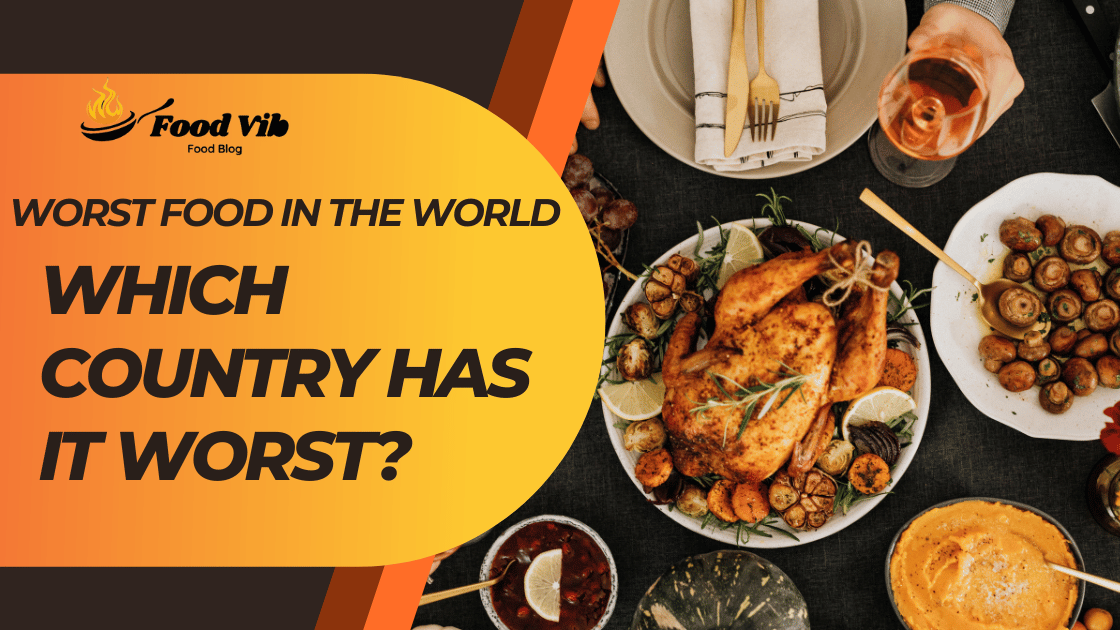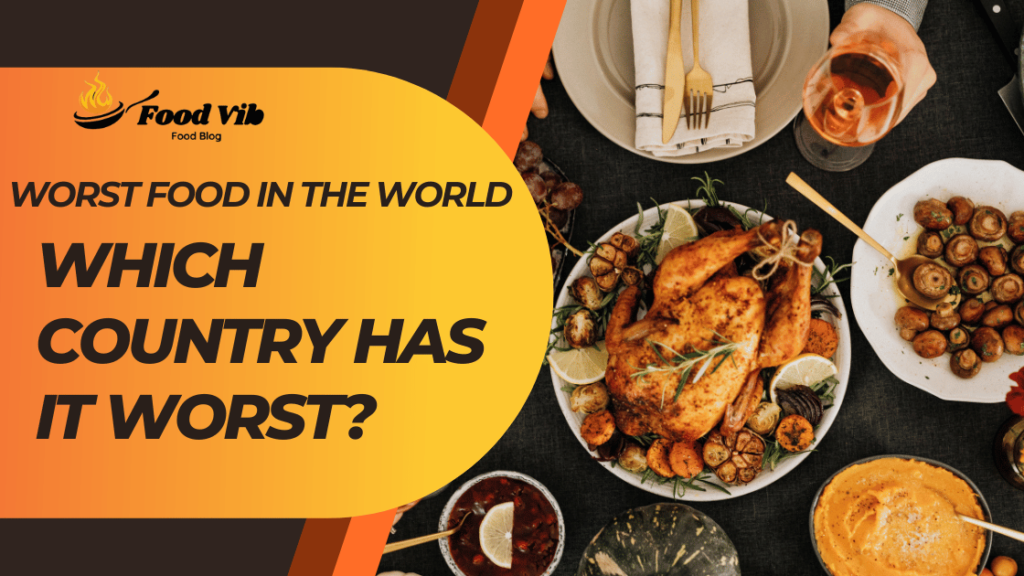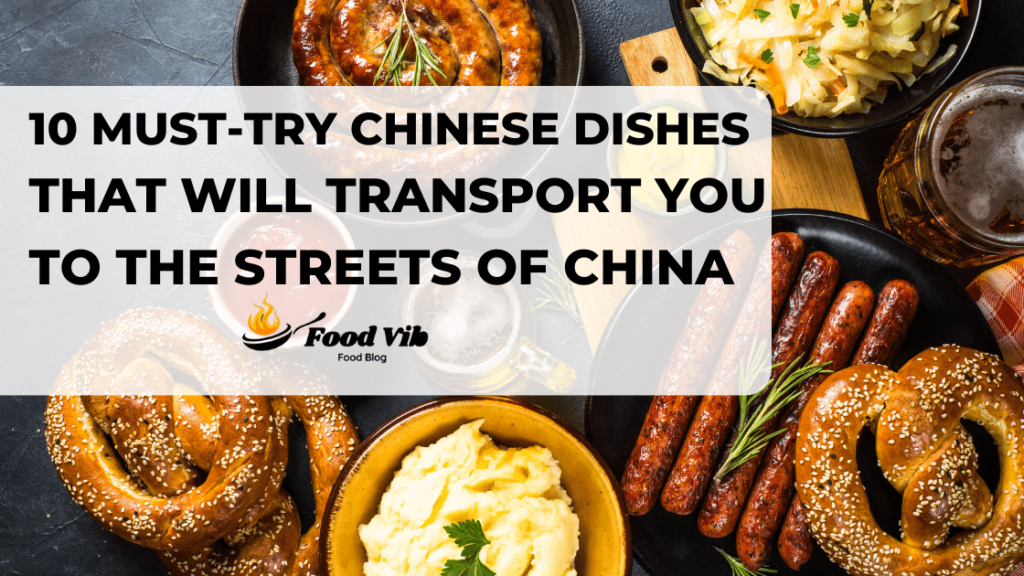The Worst Food in the World. Which Country Has It Worst?

There is a great deal of disagreement regarding which nation has the worst cuisine in the world. Some say it’s the fermented fish and insects from Southeast Asia, while others think it’s the malodorous durian fruit from Malaysia. But one thing is certain: each nation has a distinctive cuisine that may not be to everyone’s liking. What one person thinks is the worst dish may be a delicacy to another, like the fiery curries of India or the blood sausage of Scotland. In the end, everything boils down to individual tastes and cultural variances.

The Worst Food in the World
The world of cuisine is broad and varied, with a multitude of mouthwatering flavors and meals to suit a broad palate. But even among the delicious and the sublime, certain dishes are often referred to be the “worst food in the world.” While taste is a personal experience and what one person considers repulsive may be enjoyed by another, let’s investigate which nation has a reputation for having the worst cuisine by going on a tour through some notorious meals. All of the information will be presented in simple English so that everyone can understand.
1. Surströmming – Sweden’s Pungent Delicacy
On our culinary journey, Sweden is our first destination. There, the pungency of a dish called Surströmming is unmatched. Fermented herring, or surströmming, is a treat with a strong, unique smell that may be off-putting to those with sensitive noses. Traditionally, the fish is packed in a can; when the can is opened, the pressure releases, and it’s commonly characterized as a sensory overload. Surströmming has an infamous reputation due to its strong scent, even if some daring individuals could like its distinct flavor.
2. Balut – The Unique Delight of the Philippines
We next go to the Philippines, where the main attraction is Balut, an embryonic duck that has been fertilized. Balut is a street food specialty that is best served with a dash of vinegar and salt. For some who are unfamiliar with this gastronomic experience, however, the sight of a partly grown duck embryo—complete with feathers and bones—may be unsettling. Although many Filipinos consider balut to be a delicious delicacy high in protein, it has a rightful position on lists of unusual and difficult cuisines.
3. Hakarl – Iceland’s Fermented Shark
Hakarl, a delicacy made in Iceland, is made by fermenting shark flesh from Greenland. The shark is buried for weeks in a mixture of sand and gravel, left to rot, and then hung to dry. The end product is a strong, ammonia-infused meat that is said to be an acquired taste. Hakarl is a very aromatic and flavorful cuisine that divides people; while some find it interesting, others find it difficult to eat.
4. Natto – Japan’s Slimy Fermented Soybeans
Our gastronomic journey brings us to Japan, where fermented soybeans, or natto, are regarded as acquired tastes due to their slimy texture and distinctive scent. Rich in minerals, natto is often eaten with rice and has a pungent, fermented flavor that may take some getting used to. Some consider it an unusual dining experience because of its sticky stickiness and strong fragrance.
5. Casu Marzu – Italy’s Maggot-Infested Cheese
Discover the traditional cheese Casu Marzu in Sardinia, Italy. Its distinctive manufacturing method makes it stand out among other cheeses. A particular kind of cheese fly called Piophila casei lays eggs in this cheese as it ferments. After hatching, the larvae aid in the fermenting process, giving the finished product a creamy, smooth feel. Casu Marzu’s contentious reputation stems from the live maggots that some people see as a delicacy.
6. Century Egg – China’s Aged Delicacy
Now, we continue our gastronomic tour across China, home of the lengthy history of Century Egg, or preserved duck egg. These eggs have a gelatinous egg white and a dark, creamy yolk because they are immersed in a solution of clay, ash, salt, quicklime, and rice straw for a few weeks or months. For those who are unfamiliar with this Chinese treat, the sight of a blackened egg may be unnerving, even though it is loved by many for its distinct taste and texture.
A World of Diverse Tastes
Opinions on the “worst food” in the world of cuisine are quite diverse. Something disgusting to one person could be seen as a special and treasured ethnic cuisine by another. The complex tapestry of international customs and preferences is reflected in the variety of culinary styles. Even if certain foods have a reputation for being difficult, it’s important to approach them with an open mind and the knowledge that everyone’s tastes are different.
Must Read: The Impact of Chinese Food on Your Bowel Movements Learn Now
10 Must-Try Chinese Dishes That Will Transport You to the Streets of China

Chinese food has developed into a complex tapestry of tastes and textures that fascinate the taste senses throughout centuries-long culinary exploration. These 10 Chinese meals are a must-try for anybody wishing to take a culinary excursion that will take them to the busy streets of China.
1. Peking Duck: A Culinary Masterpiece
Savor Peking Duck, the pinnacle of Chinese gastronomic perfection. This delicacy, which originated in Beijing’s imperial kitchens, has soft, juicy beef under a crispy, golden-brown exterior. Every taste is a symphony of tastes, especially when accompanied with delicate pancakes, hoisin sauce, and fresh scallions.
2. Dim Sum Delights: A Taste of Cantonese Tradition
A classic Cantonese dish, dim sum elevates your dining experience. Dim sum is a culinary journey that is best enjoyed with others, ranging from steaming dumplings to dainty buns stuffed with savory treats. Take a gastronomic tour through China’s busiest dim sum establishments.
3. Sichuan Hot Pot: A Spicy Affair
Sichuan Hot Pot’s spicy appeal will ignite your taste senses. A pot of fragrant, tongue-tingling soup is used to prepare a variety of meats, veggies, and noodles during this communal meal experience. Get ready for a taste explosion that embodies the audacity of Sichuan cooking.
4. Xiao Long Bao: Soup Dumplings to Savor
Xiao Long Bao: Soup Dumplings to Savor Savor the exquisite soup dumplings that enthrall with each mouthful, a work of artistic skill. These delicately folded dumplings have thin, transparent shells that enclose a delicious soup. This culinary masterpiece’s explosion of warm, flavorful liquid is a monument to the care and precision that went into making it.
5. Kung Pao Chicken: A Spicy Stir-Fry Sensation
Kung Pao Chicken has the ideal ratio of flavor to fire. Tender chicken, crispy peanuts, and bright veggies are combined in this classic Sichuan meal and served with a hot, flavorful sauce. The end product is a symphony of flavors and textures that perfectly captures the intricacy of Chinese cooking.
6. Yangzhou Fried Rice: A Harmony of Ingredients
Indulge in the harmonious flavors of Yangzhou Fried Rice. This meal, which comes from Yangzhou, is made with fluffy rice and a variety of toppings including peas, ham, and shrimp. The end product is a delicious and aromatic masterpiece that perfectly captures the variety of regional Chinese cuisine.
7. Mapo Tofu: A Flavor Explosion
Take Mapo Tofu on a trip full of taste. This delicacy, which originated in the Sichuan area, is made with smooth tofu dipped in a hot, fragrant sauce. Bold and distinctive, the mix of spicy chili oil and chilling Sichuan peppercorns delivers a powerful sensory experience.
8. Hainanese Chicken Rice: Simplicity at its Best
Savor the grace and simplicity of Hainanese chicken rice. A mainstay of Hainanese cooking, this meal is known for its aromatic rice and delicate poached chicken. It is the epitome of comfort food done with style, especially when served with a side of ginger sauce.
9. Scallion Pancakes: Crispy and Irresistible
Taste the crispy deliciousness of these pancakes with onions. Flavored with aromatic onions, this batter is simple but tasty, resulting in golden pleasures. Scallion pancakes are a perfect example of Chinese food done simply, whether they are eaten as a side dish or as a snack.
10. Sweet and Sour Pork: A Timeless Classic
Sweet and Sour Pork: An Everlasting Classic Savor the everlasting charm of sweet and sour pork. This famous meal consists of tender pork chunks that are well-balanced between sweet and sour sauces. It’s a gastronomic adventure that has a symphony of tastes and vivid hues that goes beyond time.
Conclusion
To sum up, these 10 Chinese foods that you really must eat are like a ticket to the colorful streets of China. Chinese food is defined by the different regional tastes, creativity, and traditions that are explored via each mouthful.
Must Read: Exploring the Risks of Purchasing Food from Amazon Learn Now
FAQ (Frequently Asked Question)
Which country is often regarded as having the best food globally?
Because of its rich culinary history, variety of regional specialties, and focus on premium, fresh ingredients, Italy is often recognized as having the greatest food in the world.
What makes Italian cuisine stand out as the best?
The focus on fresh ingredients, simplicity, and geographical variation make Italian food unique. Italian food is famous for its pasta, pizza, olive oil, and wine.
Are there any specific countries known for consuming less junk food?
Japan is often mentioned as a nation where the consumption of junk food is lower. Fresh, in-season foods and classic Japanese meals like sushi and sashimi are hallmarks of the Japanese diet.
What are some healthy alternatives to traditional junk food?
Snacks like fresh fruit, hummus-topped veggie sticks, berry-topped yogurt, and almonds are healthy substitutes for typical junk food. These choices provide nutrition devoid of harmful fats or copious amounts of added sugar.
How does cultural diversity influence the variety of foods in a country?
A country's culinary traditions, ingredients, and cooking methods are greatly influenced by the diversity of cultures living there. This variety produces a wide variety of meals and tastes.
What role do food markets play in showcasing a country’s culinary identity?
Food markets, with their extensive selection of regional and traditional foods, are essential for presenting a nation's culinary identity. They provide a window into the genuine tastes and culinary traditions of a place.
How does the concept of “farm-to-table” contribute to the quality of food in a country?
The "farm-to-table" movement places a strong emphasis on obtaining locally grown, fresh products. By guaranteeing freshness, assisting regional farmers, and lessening the environmental effect of long-distance food transportation, improves the quality of food.
Can a country’s food contribute to its tourism industry?
Yes, a nation's cuisine may have a big impact on its travel and tourist sector. Culinary tourism is becoming more and more popular as tourists look for unusual and genuine dining experiences, elevating food to a central role in the allure of a place.
In your opinion, what is the best food in the world, and why?
The "best" food is, although a lot of people like Japanese food because of its focus on using fresh, premium products and its harmonious balance of tastes. Foods like tempura, ramen, and sushi are often cited as examples.






3 Comments